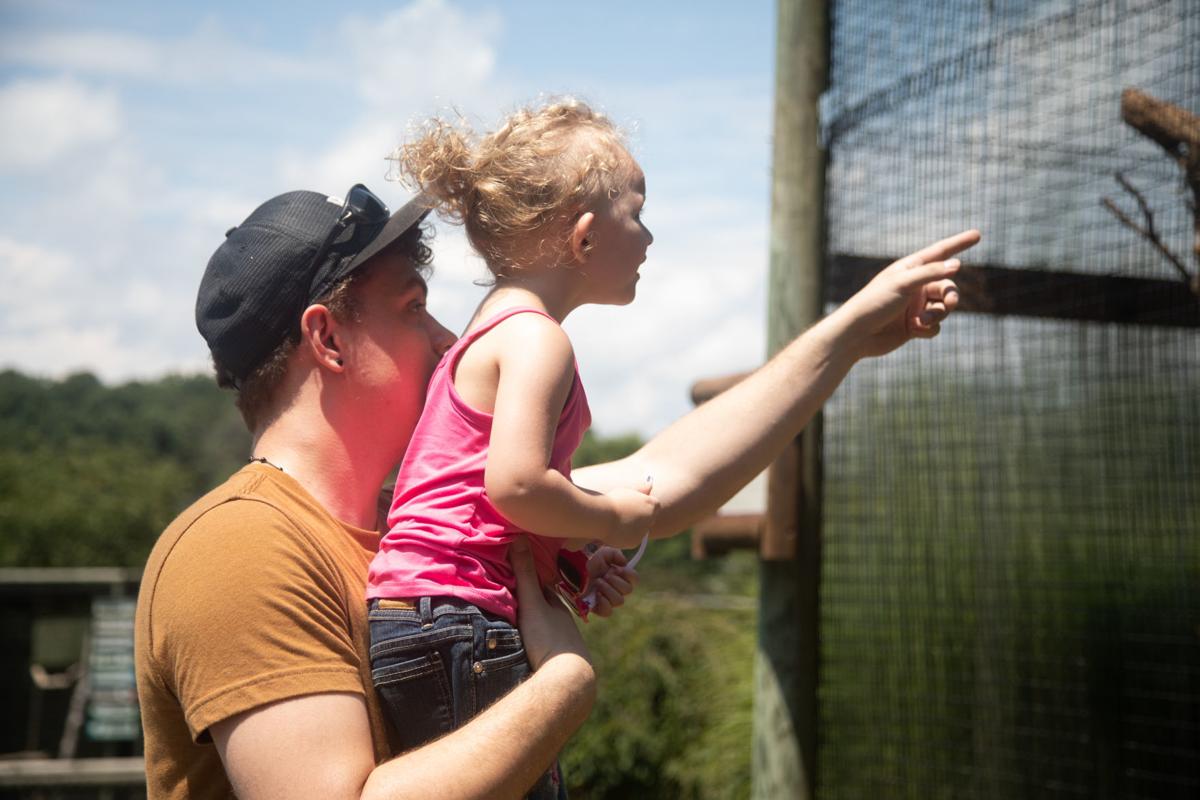NATURAL BRIDGE, Virginia: Sarah Friedel said working with animals of more than 100 different species – including llamas and camels – has taught her one thing: Spit happens. “This is a really fun place to work,” said Friedel, the assistant curator at Virginia Safari Park in Natural Bridge. “However, things can sometimes get sticky.” Each year from March to November, thousands of visitors come to the 180-acre, drive-through zoo to get in touch with nature.
Literally in touch, Friedel said. “What makes this park special is that people can interact with the animals as they go through the park,” Friedel said. “I don’t know of many places where you see this many animals in a natural environment.” Visitors can feed about 2,000 animals from around the world while driving over three miles of gravel roads that wind through the park. Ostriches and Watusi from Africa; emus from Australia; llamas from South America; elk and bison from North America; and a variety of deer from Asia and Europe freely roam through the property, coming up to vehicles to eat from buckets of feed that can be purchased at the park’s entrance. Friedel said many of the animals are not shy about sticking their heads inside a vehicle’s window to find feed if it’s not being offered.
“A lot of people comment about the ostriches because they can get way inside a vehicle with those long necks,” she said. “They will go right after the feed and it’s really exciting because they are right there in the car with you.”
Friedel said many of the animals even stake out their favorite spots along the gravel roads and wait for vehicles to drive by. “They know when the park is opening and usually a crowd is at the front gate waiting for people to start driving through,” she said. “Most of them come up to the front gate the day we reopen for the season each March because they have missed all of the people coming through giving them treats and they get excited.”
Still, Friedel said many of the animals choose to watch visitors to their habitat from a distance. “They get plenty of food every day from park staff and the food they get from visitors is more like dessert for them,” she said. “A lot of them will just watch people drive by or sunbathe in the middle of the road and block traffic. They can do whatever they want, and that’s the cool thing about driving through here and seeing these animals because they have no rules, just like in the wild.”
Friedel said the animals that do opt for additional food have learned which vehicles to approach. “When they see our work trucks, they ignore us,” Friedel said. “They know who works here and who is visiting the park,” Friedel said the park’s 50 employees know the individual animals, as well as the animals, know them.
“All of our animals have names except for the deer because there are so many of them,” Friedel said. “We have to know each of them and count them every day to make sure everyone is doing OK and are accounted for.”
Friedel said familiarity with the animals also comes in handy when staff have to vaccinate the park’s 2,000 inhabitants. “We have to know which of them kick, bite or spit,” she said.
In addition to the drive-through safari, the park also has a 10-acre walk-through area that includes a petting zoo with pygmy goats and baby llamas; habitats housing African penguins, anteaters, Bengal tigers, wolves, kangaroos and a variety of snakes and lizards; and a free-flight aviary that houses more than 600 budgies from Australia. Friedel said the birds – which guests can feed with special “budgie sticks” – are among the most popular attractions with children.
“We get a lot of school groups and this is the biggest hit with the kids,” she said. “They love the budgies landing on them and perching. They are really sweet birds.” Lillian May, 8, said she wanted to take one of the birds back to her home in Roanoke.
“I want one so bad,” Lillian said. “I’m asking for one for Christmas,” Friedel said the park’s spider monkey habitat also is a popular stop in the walk-through area. “Most people stop and watch the monkeys while they are here,” Friedel said. “Adults love them just as much as the kids do.”
Joel Farthing, of Boone, North Carolina, joked about the similarities he saw between his children and the spider monkeys they were watching on a recent Wednesday afternoon. “The only difference I see is that the monkeys don’t fall as much,” Farthing said, laughing. “Other than that they’re the same creatures.”
Farthing brought his 7-year-old son, Colt, to the park last year when the two were traveling through the area. Farthing said the experience “raised the bar” for his son on a trip to the zoo. “His school took a trip to the zoo in Asheboro (North Carolina) last year and he said there was no comparison,” Farthing said. “He has been wanting to bring his sister and grandmother here ever since he came here so we took a road trip to bring them here. My son has been this park’s biggest advertiser because he tells everyone about it.”
Charlotte Alderage spread the word about her visit to Virginia Safari Park two years ago all the way to her home in Birmingham, England, and brought her two sisters to the park this month while they were visiting relatives in Richmond.
“Coming here was certainly on my to-do list during this holiday,” Alderage said. “There is nothing like this where I live and it’s simply wonderful. I knew I had to bring my sisters with me this visit.” Friedel said word of mouth is the best advertisement for the park.
“That’s how most people hear of us,” she said. “Word really gets out and we are surprised at where a lot of our visitors have come from. Not too long ago, we had a Jeep pull through here with Hawaii license plates and just about everyone noticed those plates.”
Friedel said she is equally surprised at how many people living within an hour’s drive of Natural Bridge have never heard of Virginia Safari Park.
“We get that a lot from first-time visitors that have lived in the area for years,” Friedel said. “A lot of people say they never imagined something like this right down the road for all that time and they didn’t know about it.” However, Friedel said the park has its fair share of local regulars.
“We have a couple people that come pretty frequently to shoot wildlife photography because we have such a variety of species here,” Friedel said. “Another woman comes pretty regularly and does sketches of all the different animals. It’s great that they feel like ourpar k is the best place to watch these animals in a natural environment.
“It doesn’t get more natural than out here,” she said. “We are really proud of our park.”AP







